‘Baloney Sandwich Index’ shows a 4% drop in Fort Smith sack lunches served in 2015
by February 11, 2016 1:41 pm 211 views

The 2015 Baloney Sandwich Index wasn’t too far off Fort Smith metro job growth numbers during the year, but it doesn’t necessarily indicate an improving jobs scene in the area for 2016.
While not a true index, Ken Kupchick, director of marketing and development at the River Valley Regional Food Bank in Fort Smith, has cleverly used the numbers to raise awareness of the St. John’s Episcopal Church Sack Lunch program in downtown Fort Smith. Kupchick has said the monthly index has a 70% correlation with Sebastian County unemployment numbers. Much of the food used the program is donated through the Food Bank.
LUNCHES AND JOBS
An annual look at the numbers that form part of the index shows that 53,293 sack lunch meals were served in 2015, down 4% compared to 2014. Average monthly employment in the Fort Smith metro was 114,242 in 2015, up 2.37% compared to 111,588. However, the 2015 monthly average was 7.3% below peak of 123,254 in 2007. (The 2015 figure is subject to future revisions by the U.S. Bureau of Labor Statistics.)
“The Sack Lunch Program prepared enough sandwiches in 2015 that if you laid them end to end on Fort Smith’s Riverfront Drive, starting at Miss Laura’s, they would stretch all the way over the Midland Avenue bridge onto Broadway Avenue in Van Buren,” Kupchick said in an e-mail report about the program. “That’s 7 miles of sandwiches – a total of 76,198 sandwiches in almost 53,300 sack lunch meals.”
Following is the previous 10 years of sack lunches served per year.
2015: 53,293
2014: 55,493
2013: 46,321
2012: 60,200
2011: 50,984
2010: 39,787
2009: 41,372
2008: 31,124
2007: 30,441
2006: 31,949

Following is the average monthly employment in the Fort Smith metro during the previous 10 years.
2015: 114,242 (subject to revision)
2014: 111,588
2013: 111,277
2012: 113,821
2011: 114,160
2010: 115,923
2009: 116,427
2008: 122,871
2007: 123,254
2006: 122,993
‘MORE NUTRITIOUS FOOD’
Jean Kolljeski, coordinator with the Sack Lunch Program, wasn’t sure why there was a decrease in lunches served, but cited several factors that may have helped reduce demand.
“One of the things is that we had warmer winter, so maybe people were paying less with electric bills and they had more money for food,” she said. “And I’d like to think that maybe … jobs are coming to them, but I just don’t know.”
She said the program also noted a dip in the number of children served, with 3,647 in 2015 and 4,322 in 2014.
Each meal includes a sandwich – sometimes two – with fruit and other healthy side items, although sometimes they provide what is donated. The lunch also comes with a carton of milk, which is often the only milk people receive, and is part of the focus to boost the nutrition value per serving.
“We’re giving more nutritious food than we ever did before,” Kolljeski said, adding that the more nutrition per meal may also play a factor in fewer lunches being served.
Not all of those who use the service are homeless or unemployed. A 2014 survey of those served by the program included the following results:
• 68% lived in a home or apartment;
• 14% were employed;
• 57% live within a mile of the sack lunch program distribution point near St. John’s Episcopal Church in downtown Fort Smith; and
• 27% are retired or disabled.
One thing Kolljeski does know is that the program wouldn’t make it without support from 24 churches, companies like Mrs. Baird’s bread, and local restaurant owners like Tom Caldarera. Mrs. Baird’s donated in 2015 all the bread for the more than 53,000 sandwiches made. Caldarera, owner of Taliano’s restaurant in Fort Smith, shows up most every Tuesday and Thursday with a “huge, huge pot of soup” that feeds around 150 people, Kolljeski said. She said several members of the Caldarera family often show up to help serve the soup.
“I can’t thank them enough,” Kolljeski said of volunteers and those who help donate food. “We serve out of 15 refrigerators. … It’s a lot every day, and this is really a safety net program for many people, many families.”
